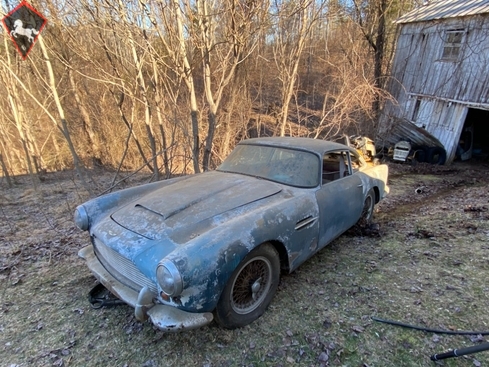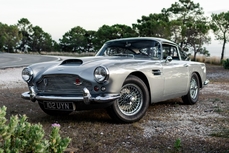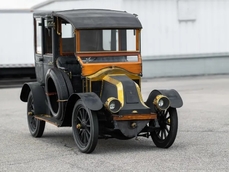Aston Martin DB4 1962
General description :
It Can Only Be Original Once: 1962 Aston Martin DB4 with Matching Numbers Discovered Out of 40+ Year Ownership and 30 Year Barn StorageThis 1962 Aston Martin DB4 is an incredibly exciting and original discovery out of over 40 year ownership. Blue with red leather interior. Retaining its matching numbers engine, this DB4 has been sitting in storage for the last 30 years patiently awaiting restoration. After the previous owner returned from Vietnam in the 1970's, he went back to work at a local body shop. When his boss asked him to help with a repair on his own car, he agreed to go over to his house and work on the car. He worked on the car over the course of a few weeks and once he completed the job, his boss gifted him the Aston Martin DB4. He had the car towed home and planned on restoring it but just never got around to it. He parked it in a barn where it sat until recently when it finally saw the light of day after over 30 years in storage.The introduction of the Aston Martin DB4 marked a new era for the British sports car manufacturer that would restore performance and prestige to the fabled marque. Wrapped in a seductive, lightweight alloy body fashioned by Carrozzeria Touring of Milan and featuring a powerful 3.7-litre engine, the DB4 offered performance to match its pedigree, becoming the worlds first production car to achieve 0-100-0 mph in under 30 seconds. Exceptionally Original and Rare DB4Retaining its Matching Numbers EngineOffered from 40+ Year OwnershipA True Barn-Find Out of 30 Year StorageA Rare and Collectible Aston Martin from the Golden Era Price: $325,000
https://www.gullwingmotorcars.com/1962-aston-martin-db4-c-4254.htm
1962 Aston Martin DB4 is listed sold on ClassicDigest in Astoria by Gullwing Motor for $325000.
Car Facts
Car type : Car Make : Aston Martin Model : DB4 Engine size : 0.0 Model Year : 1962 Location : Astoria
Sold
Seller Information
Sold
People who viewed this Aston Martin DB4 also viewed similar Aston Martin listed at ClassicDigest
Other cars listed for sale by this dealer
About Aston Martin DB4
The Aston Martin DB4 is an iconic model in Aston Martin's history, known for its elegant design, performance, and luxury. Here's an overview of its history, specifications, production numbers, and cultural context:1. History: The Aston Martin DB4 was introduced in 1958 as a replacement for the DB Mark III. It was designed by Carrozzeria Touring of Milan, Italy, and represented a significant step forward for Aston Martin in terms of performance and styling.
2. Specifications:
- Engine: The DB4 initially featured a 3.7-liter inline-six engine, which was later upgraded to a 4.0-liter engine in later models. The power output ranges from approximately 240 to 266 horsepower, depending on the specific variant.
- Transmission: It was equipped with a 4-speed manual transmission, and some later models were offered with a 3-speed automatic transmission as an option.
- Performance: The DB4 was capable of achieving a top speed of around 140 to 150 mph (225 to 240 km/h) and could accelerate from 0 to 60 mph (0 to 97 km/h) in approximately 8 seconds.
3. Production Numbers: The production numbers for the Aston Martin DB4 are as follows:
- Aston Martin DB4 (1958-1963): Approximately 1,113 units produced across various body styles and variants.
4. Cultural Context: The Aston Martin DB4 represented a significant leap forward for Aston Martin in terms of design and performance. It showcased a blend of British craftsmanship and Italian styling, incorporating lightweight construction techniques and elegant lines. The DB4's luxurious and sporty character made it a desirable choice for discerning buyers, including celebrities and enthusiasts.
The DB4's success on the road and its participation in motorsport events further enhanced its reputation. It competed in various racing and rallying events, achieving notable successes, including class wins and overall victories in races such as the Le Mans 24 Hours and the RAC Tourist Trophy.
The Aston Martin DB4 remains an iconic and highly sought-after classic car today. Its timeless design, powerful performance, and connection to Aston Martin's heritage have made it a symbol of automotive excellence and desirability. Collectors and enthusiasts value the DB4 for its rarity, craftsmanship, and historical significance within the Aston Martin lineup.
"Superleggera" is an Italian term meaning "super light" or "super lightweight." It is often associated with the coachbuilding company Carrozzeria Touring Superleggera, which has been known for its lightweight construction techniques used in the creation of various iconic automobiles.
Carrozzeria Touring Superleggera is credited with popularizing the superleggera construction method, which involved using a lightweight framework of small-diameter steel tubes covered with hand-formed aluminum panels. This construction technique reduced the overall weight of the vehicle while maintaining structural integrity.
The term "Superleggera" has also been used by several automakers, including Aston Martin, Lamborghini, and others, to denote special lightweight or high-performance versions of their vehicles. These vehicles often feature weight reduction measures, aerodynamic enhancements, and increased power output to deliver enhanced performance and driving dynamics.
For example, Aston Martin has used the "Superleggera" designation on models such as the Aston Martin DBS Superleggera, which represents the ultimate expression of performance and luxury in the Aston Martin lineup. These vehicles typically feature powerful engines, advanced aerodynamics, and extensive use of lightweight materials to achieve a perfect balance between performance and luxury.
In summary, "Superleggera" refers to the concept of lightweight construction and has been associated with both the Carrozzeria Touring Superleggera coachbuilder and specific high-performance models from various automakers. It represents a pursuit of weight reduction and improved performance without compromising on style and luxury.
















